My first pelagic trip
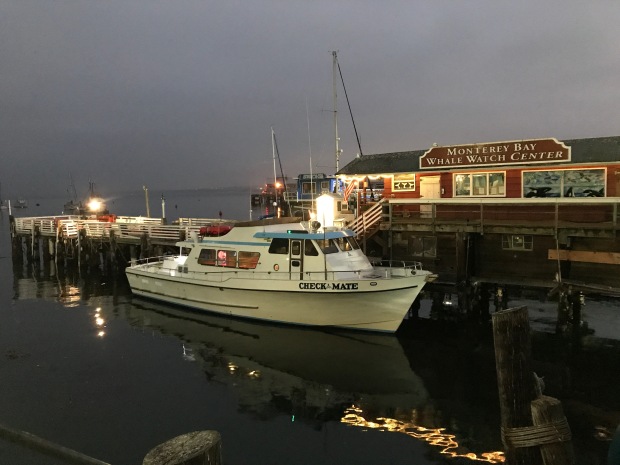
All I could envision was my body flung over the side of a fishing vessel, throwing up into the water as we bobbed up and down in the ocean. I had read all about pelagic trips where you go out into the ocean looking for sea birds and I heard more stories about the sea sickness than I had about any particular birds people would find. I’m such an inexperienced birder and a slow hiker, both of which can be annoying to more savvy birders, but I had no idea how I’d do on a pelagic trip. I didn’t need “throwing up” added to my list of reasons for people to not go birding with me.
Steve wasn’t new to pelagic trips, but he hadn’t been to the one out of Monterey Bay and he’d been not-so-subtly hinting at it ever since we married ten years ago. I kept putting it off, not because I don’t love the Monterey Bay—I love the place and wanted to introduce Steve to it as well as Carmel-by-the-Sea as they’re both treasured places in my heart. But my hesitation was driven mostly because I didn’t want to throw up on a trip.
Plus I’m stupid at ID’ing birds. Just plain stupid. And I couldn’t tell a skua from a shearwater from a gull. Really. (Let me spoil the ending for you: STILL CAN’T.)
However, the time came to do a California trip last Fall. Steve had been recovering from three surgeries over the summer after two different and unrelated cancer diagnosis and I didn’t think it was a good idea to do a challenging trip out of the U.S. in the Fall, which is when we typically go abroad. So rather than go back to Panama to visit the Darien region (which had been our original plan) I suggested we go to the California Bay Area and spend some time there as I showed him around where I used to live, and I was going to do all the driving so he could relax and enjoy the beautiful California scenery. And to help put an end to the dreary six months Steve had endured with doctors and surgeries, we were finally going to do one of the Shearwater Journeys out of Monterey Bay.
Our trip started in Silicon Vally and after a few days of birding on the peninsula at Shoreline Park and at Rancho San Antonio, eating at all my favorite restaurants and spending a day at Half Moon Bay, we headed down to Monterey Bay where John Steinbeck is still celebrated. Many of the buildings on Cannery Row are reminiscent of the depression-era sardine canneries from Steinbeck’s Cannery Row, yet a far cry from the “…scattered, tin and iron and rust and splintered wood, chipped pavement and weedy lots and junk heaps, sardine canneries of corrugated iron, honky tonks, restaurants and whore houses, and little crowded groceries, and laboratories and flophouses,” as described by Steinbeck in his novel. Instead, you’ll find the streets lined with boutique shops and restaurants, people sipping wine on high stools in the wine-tasting rooms, and children eating overpriced Dippin’ Dots ice cream as they skip toward the famed Monterey Bay Aquarium at the end of Cannery Row street.
Reconnaissance
We arrived the afternoon before our trip and scouted out the area so we were familiar with the meeting place we needed to be at early the next morning. After our little reconnaissance, we found an Italian restaurant with views facing the water and I panicked when I read the menu, completely at a loss for what to eat. Not because I was overwhelmed by all the choices, but I couldn’t figure out what would least likely make me throw up the next morning. I remember reading something in Debi Shearwater’s printed materials she sent to us in advance about avoiding greasy foods. And is Italian considered greasy? Should I not put butter on my roll? Are creamy sauces bad? Oh hell, I thought. I just ordered the penne with pesto and figured a little butter on my roll would be okay. (Fingers crossed.)

Cannery Row
All aboard!
It was dark when we arrived at the meeting point at Fisherman’s Monterey Wharf early in the morning. I had forgotten what a little chill in the morning felt like after being in Central Texas for over two years. The shop for the whale watching tours was open and they had coffee and tea for the early risers—the pelagic birders (us) and those going on a fishing trip on another boat. Steve and I poured hot water and dipped our tea bags in the water and it was too hot to drink, but my fingers on the warm cardboard cup warmed up quickly.
As we waited for our crew to arrive we spotted this sea otter playing in the water, turning over and over like a log.
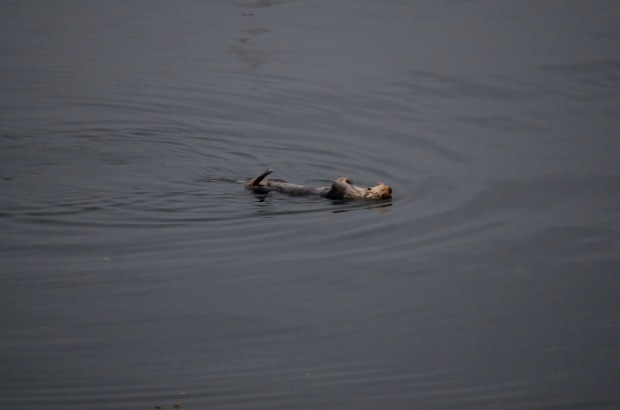
Sea Otter
Finally our crew arrived and we received our instruction: “Don’t go into the cabin if you get seasick. It will just make it worse. Everyone point out whatever you see and we will help you ID it if you need it. Make sure you’ve eaten. There’s a toilet inside the cabin, down the steps, but did we mention to not go into the cabin if you get seasick? Just don’t.”
I wasn’t going to go in that cabin if I could help it.
Steve and I sat on a bench outside the cabin and the boat crept slowly as we were leaving Monterey Bay. Hundreds of California Sea Lions were lounging on the rocks in the bay as if glamorous movie stars and the Brandt’s Cormorants were scattered around them like Hollywood hanger-ons.

Brandt’s Cormorants and California Sea Lions
The boat was equipped with a sound system where the guy at the helm would call out through a microphone what he could see and we could hear over the speakers in the back of the boat. We weren’t even out of the bay and we heard over the speakers, “Black Turnstone on the rocks! Next to the Brandt’s Cormorant. Got it? Everyone see it?” Someone pointed with their finger and I followed it and found the little bird to the right of the Cormorant. Click, click, click and I was satisfied I got the shot.

Brandt’s Cormorant and Black Turnstone
Not even 30 seconds later the same voice over the speaker hollered, “Pair of Black Oystercatchers!” I didn’t need a finger to point for me this time. I saw their bright red beaks immediately and began snapping photos.

Black Oystercatchers
Let me pause here as you absorb and marvel at the birds in these two above photos. Take it all in, because I’m going to be honest with you: Those are the best photos you’re going to see from this trip. The rest of the trip involved a LOT of bobbing up and down and up and down and up and down over great swells, and it was a challenge to get any good shots. (The video below gives you a good idea of how it was.)
That and the fact that I suck at getting shots of birds in flight.

South Polar Skua. Really. Can’t you tell?
And I was always facing the wrong direction where light is concerned.
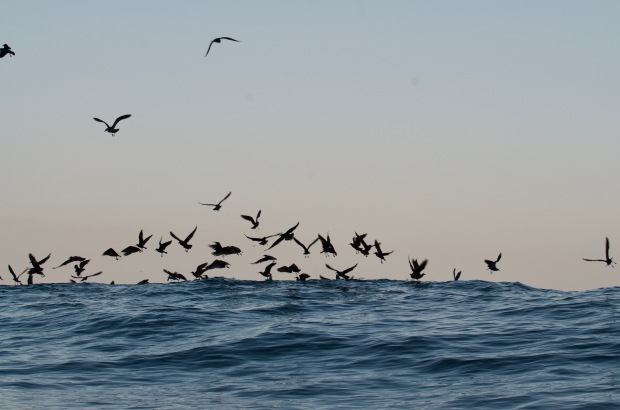
Gulls swooping in to get the free lunch of chum.
Fast and furious
Everything happens so fast on a pelagic trip. Birds swoop in fast from every direction and you have to get your binoculars on the bird quickly as it appears over the horizon before it disappears as quickly as it came. I often didn’t know what direction to look and most of the time I didn’t know what I was looking at. Someone would yell, “Sooty Shearwater!” and I didn’t know what they were pointing to. In fact, most people didn’t point, but just had their binoculars up at their eyes and so I’d follow the direction of their binoculars and would just look up into the sky and pretend like I was seeing something.
I’m pretty certain it was a gull I was looking at and whatever spectacular bird that was actually called had flown away.
Steve would often ask, “Did you see it?” and I would just nod. I think he knew I was lying. I didn’t want to get in the way of him or anyone else seeing the birds. I felt like they wanted to ride their bikes fast up the hill and I was still managing my training wheels and didn’t want them to have to worry about helping me. Let’s be honest, it’s a lot more fun to race up the hill than to worry about the person struggling with the training wheels. I contemplated why I was in this predicament while I munched on my salty pretzels that I had packed because of advice I read online from a birder who had been on pelagic trips. The salt was to help with any nausea. I wasn’t feeling squeemish, thankfully, but I wanted to stay ahead of any sea sickness should it sneak up on me. As I ate the pretzels I was determined that next time I would study the birds in the field guide before I go on a pelagic trip.
But I was getting super good at taking photos of gulls in the meantime. Okay, maybe not super good. Just good. And as long as they weren’t really moving.

California Gull

California Gull (immature)
And occasionally I sort of got an interesting bird, but the photos just weren’t all that great.

Buller’s Shearwater

Common Murre (immature)
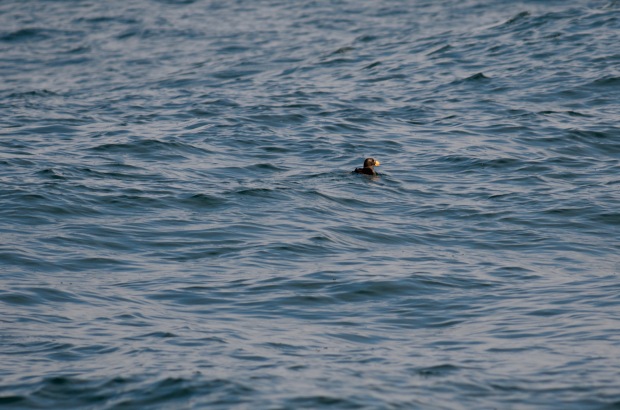
Probably the least interesting photo you’ll ever see of a Tufted Puffin
Examining one’s self
After we got back to shore, we spent the afternoon exploring the Monterey Bay Aquarium, had a nice dinner and as we walked by the marina at dusk I noticed the light shining on the boats, and it seemed to open up a passage from John Steinbeck’s Cannery Row:
“It is the hour of the pearl—the interval between day and night when time stops and examines itself.”
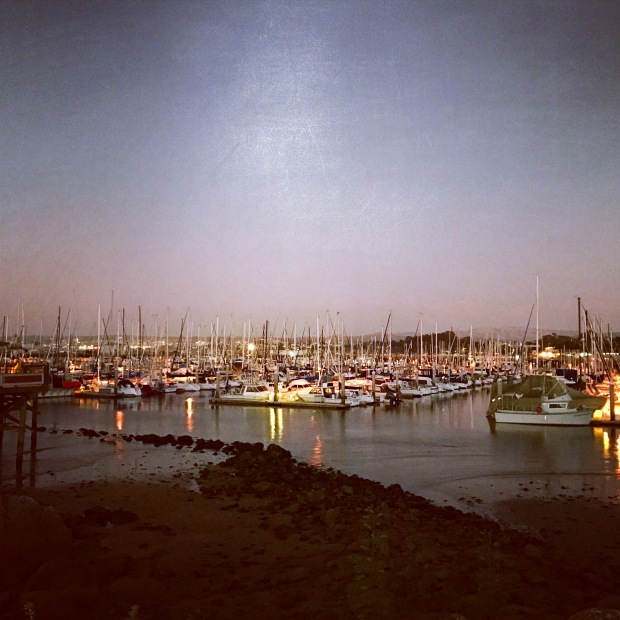
My day was not a failure, although it could have easily felt like that. I took away from it valuable insights and I don’t look at this as the only pelagic trip I’ll ever do. In my own examination—
- I learned that I need to spend time studying the birds before my next trip
- I realized for my next pelagic trip I’m going to ditch taking my camera because for me it’s a handicap, since I’m not all that great at photography. I spend more time focusing on getting the shot where I should spend time looking at the birds through my binoculars.Once I get the hang of the up down up down up down of the swells while looking for birds, and once I know what I’m looking for or at, then it makes sense to take the camera.
- Ask for help. People were there to help—My husband, the crew, even other birders. I just didn’t want to look stupid in front of others and ask for their help, and in the end, I didn’t get out of it as much as I could have. Most birders like to help others. I would want to help others if I could, so why not take advantage of the kindness others offer?
But let’s not kid ourselves. I think the biggest achievement of the day was not throwing up, so overall, it was a big success.
The List
Below are the list of birds reported from this trip. I can’t say which ones I actually saw, because so many of them looked the same to me and flew right by us so fast.
- Common Loon
- Brown Pelican
- Parasitic Jaeger
- Common Murre
- California Gull
- Peregrine Falcon
- Brandt’s Cormorant
- Black Oystercatcher
- Black Turnstone
- Surfbird
- Heermann’s Gull
- Western Gull
- Elegant Tern
- Greater White-fronted Goose
- Pink-footed Shearwater
- Flesh-footed Shearwater
- Buller’s Shearwater
- Sooty Shearwater
- South Polar Skua
- Promarine Jaeger
- Rhinoceros Auklet
- Cackling Goose
- Northern Fulmar
- Short-tailed Shearwater
- Surf Scoter
- Tufted Puffin
- Lapland Longspur
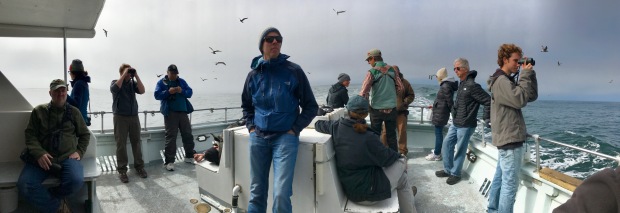

Don’t forget your Double-crested Cormorants also for your list! Love your birding tales! Fun perspective! PS – no whales???
LikeLike
Actually, we DID see some whales and a bunch of dolphins. At one point there was a flurry of activity in the water it was so exciting. SO EXCITING that I didn’t think to take a photo or even a video of it with my iPhone because it was just so magnificent and I didn’t want to take my eyes off of it. And it all happened when my husband went to use the loo so he missed it all!
LikeLike
Actually I suppose you may not have seen Double-cresteds, but I am pretty sure there are a number of Pelagic Cormorants in your photo with the Brandt’s!
Cheers!
LikeLiked by 1 person
You’re probably right!
LikeLike
As a 17 year old young birder I was crazy nervous about my first pelagic. I wanted to make a name for myseldnin the birding world up here in Washington and getting sick on a pelagic would definitely not be the way to get my name out, at least not in a good way. In the end everything went just find and I added 21 life birds and met some great people.
Loved the story. Practically everything you said was what I lived during my pelagic.
LikeLiked by 1 person
Thanks for your comment! I’m so glad to hear that my experience isn’t completely out of the ordinary. 🙂
LikeLike
Taking pictures on a rocking boat is a nightmare so your plan not to take a camera next time is probably very sound. Find an island if you want to take picture of sea birds.
LikeLike
Very wise advice.
LikeLike
What a lovely birding trip this was, with a total of 27 bird species spotted. Keep it up with such a wonderful blog highlighting your birding activities. I’m in Kenya and also have some great birding moments and wish one time you have a trip to bird watch in Kenya.
LikeLiked by 1 person
Reblogged this on Wolf's Birding and Bonsai Blog.
LikeLike